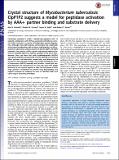Crystal structure of Mycobacterium tuberculosis ClpP1P2 suggests a model for peptidase activation by AAA+ partner binding and substrate delivery
Author(s)
Schmitz, Karl R.; Carney, Daniel W.; Sello, Jason K.; Sauer, Robert T
DownloadSchmitz-2014-Crystal structure of.pdf (2.420Mb)
PUBLISHER_POLICY
Publisher Policy
Article is made available in accordance with the publisher's policy and may be subject to US copyright law. Please refer to the publisher's site for terms of use.
Terms of use
Metadata
Show full item recordAbstract
Caseinolytic peptidase P (ClpP), a double-ring peptidase with 14 subunits, collaborates with ATPases associated with diverse activities (AAA+) partners to execute ATP-dependent protein degradation. Although many ClpP enzymes self-assemble into catalytically active homo-tetradecamers able to cleave small peptides, the Mycobacterium tuberculosis enzyme consists of discrete ClpP1 and ClpP2 heptamers that require a AAA+ partner and protein–substrate delivery or a peptide agonist to stabilize assembly of the active tetradecamer. Here, we show that cyclic acyldepsipeptides (ADEPs) and agonist peptides synergistically activate ClpP1P2 by mimicking AAA + partners and substrates, respectively, and determine the structure of the activated complex. Our studies establish the basis of heteromeric ClpP1P2 assembly and function, reveal tight coupling between the conformations of each ring, show that ADEPs bind only to one ring but appear to open the axial pores of both rings, provide a foundation for rational drug development, and suggest strategies for studying the roles of individual ClpP1 and ClpP2 rings in Clp-family proteolysis
Date issued
2014-09Department
Massachusetts Institute of Technology. Department of BiologyJournal
Proceedings of the National Academy of Sciences
Publisher
National Academy of Sciences (U.S.)
Citation
Schmitz, K. R., D. W. Carney, J. K. Sello, and R. T. Sauer. “Crystal Structure of Mycobacterium Tuberculosis ClpP1P2 Suggests a Model for Peptidase Activation by AAA+ Partner Binding and Substrate Delivery.” Proceedings of the National Academy of Sciences 111, no. 43 (September 29, 2014): E4587–E4595.
Version: Final published version
ISSN
0027-8424
1091-6490